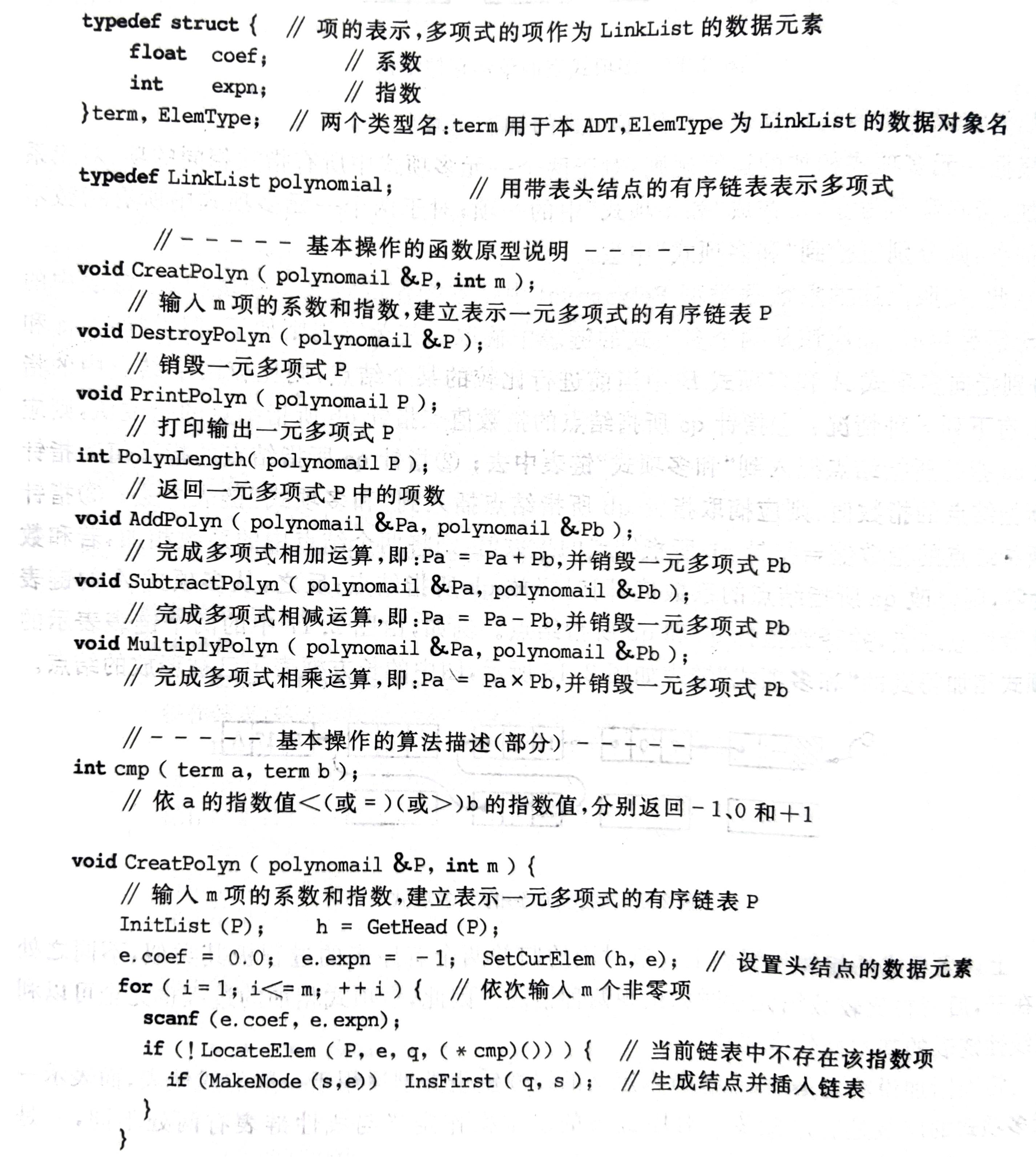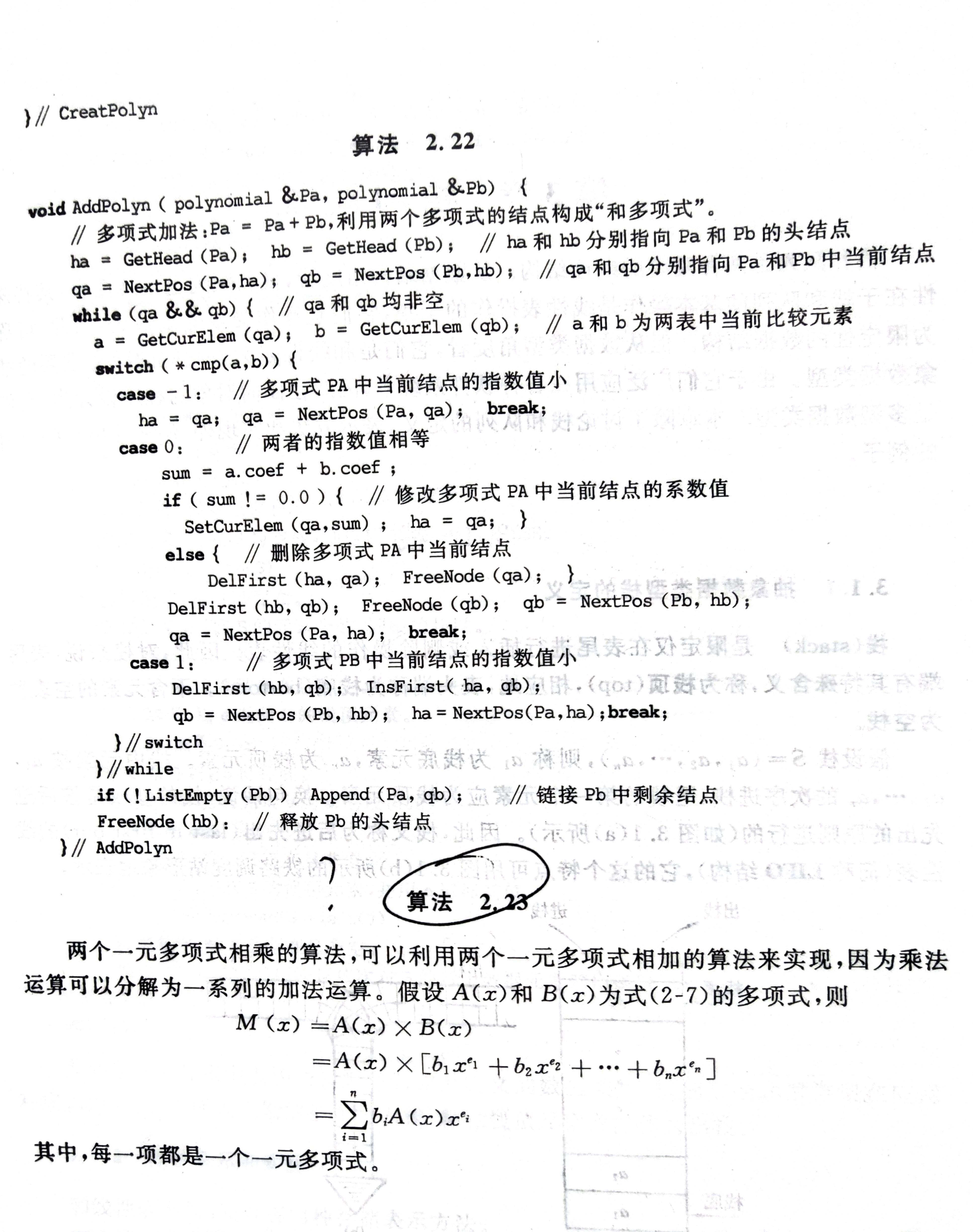[数据结构-严蔚敏版]P42多项式Polynomial的实现
Posted Wecccccccc
tags:
篇首语:本文由小常识网(cha138.com)小编为大家整理,主要介绍了[数据结构-严蔚敏版]P42多项式Polynomial的实现相关的知识,希望对你有一定的参考价值。


大家如果发现代码有错误,麻烦评论告知一下!!!
下面的代码多项式相乘的算法实现并不是书上那种,书上那种我实在是看不懂,所以用了自己的方法写了相乘的算法,就是模拟手算过程,一个一个相乘。
代码如下:
#include <iostream>
using namespace std;
typedef struct
{
double coef;
int expn;
}term,ElemType;
typedef struct LNode
{
ElemType data;
LNode *next;
}*Link,*Position;
typedef struct
{
Link head, tail;
int len;
}LinkList;
typedef LinkList Polynomial;
bool makeNode(Link &p, ElemType e)
{
p = new LNode;
if (!p) return false;
p->data = e;
p->next = nullptr;
return true;
}
void freeNode(Link &p)
{
delete p;
p = nullptr;
}
bool initList(LinkList &L)
{
L.head = new LNode;
if (!L.head) return false;
L.tail = L.head;
L.head->next = nullptr;
L.len = 0;
return true;
}
bool insFirst(Link h, Link s)
{
s->next = h->next;
h->next = s;
return true;
}
bool delFirst(Link h, Link &q)
{
q = h->next;
h->next = h->next->next;
q->next = nullptr;
return true;
}
bool append(LinkList &L, Link s)
{
L.tail->next = s;
while (L.tail->next)
{
L.tail = L.tail->next;
L.len++;
}
return true;
}
bool remove(LinkList &L, Link &q)
{
LNode *s = L.head;
while (s->next != L.tail)
{
s = s->next;
}
q = L.tail;
L.tail = s;
s->next = nullptr;
L.len--;
return true;
}
bool insBefore(LinkList &L, Link &p, Link s)
{
LNode *q = L.head;
while (q->next != p)
{
q = q->next;
}
s->next = p;
q->next = s;
L.len++;
return true;
}
bool insAfter(LinkList &L, Link &p, Link s)
{
s->next = p->next;
p->next = s;
p = s;
L.len++;
return true;
}
bool setCurElem(Link &p, ElemType e)
{
p->data = e;
return true;
}
ElemType getCurElem(Link p)
{
return p->data;
}
int polynLength(Polynomial &p)
{
int j = 0;
LNode *s = p.head->next;
while (s)
{
j++;
s = s->next;
}
p.len = j;
return p.len;
}
bool listEmpty(LinkList &L)
{
polynLength(L);
if (L.len == 0) return true;
else return false;
}
Position getHead(LinkList L)
{
return L.head;
}
Position getLast(LinkList L)
{
return L.tail;
}
Position priorPos(LinkList L, Link p)
{
LNode *s = L.head;
while (s->next != p)
{
s = s->next;
}
if (s == L.head)
{
return nullptr;
}
return s;
}
Position nextPos(LinkList L, Link p)
{
return p->next;
}
bool locatePos(LinkList L, int i, Link &p)
{
int j = 1;
LNode *s = L.head->next;
if (i < 1 || i > L.len) return false;
while (s && j < i)
{
s = s->next;
j++;
}
if (!s || j > i)
{
return false;
}
p = s;
return true;
}
bool locateElem(LinkList L, ElemType e, Position &q,int(*compare)(ElemType, ElemType))
{
LNode *s = L.head->next;
while (s)
{
if (compare(s->data, e) == 0)
{
q = s;
return true;
}
s = s->next;
}
s = L.head;
while (s->next)
{
if (compare(s->next->data, e) > 0)
{
q = s;
return false;
}
s = s->next;
}
q = s;
return false;
}
int cmp(term a, term b)
{
if (a.expn < b.expn) return -1;
else if (a.expn == b.expn) return 0;
else if (a.expn > b.expn) return 1;
}
void destroyPolyn(Polynomial &L)
{
LNode *p = L.head;
while (p)
{
LNode *q = p;
p = p->next;
delete q;
}
L.tail = L.head = nullptr;
}
void printPolyn(Polynomial p)
{
LNode *s = p.head->next;
int j = 1;
int len = polynLength(p);
while (s)
{
if (s->data.expn == 0)
{
cout << s->data.coef;
}
else
{
cout << s->data.coef << "x^" << s->data.expn;
}
if (j < len)
cout << " + ";
s = s->next;
j++;
}
cout << endl;
}
void createPolyn(Polynomial &p, int n)
{
initList(p);
LNode *s = nullptr;
LNode *h = nullptr;
LNode *q = nullptr;
h = getHead(p);
ElemType e;
e.coef = 0.0;
e.expn = -1;
setCurElem(h, e);
for (int i = 0; i < n; i++)
{
cin >> e.coef >> e.expn;
if (e.coef == 0.0)
continue;
if (!locateElem(p, e, q, cmp))
{
if (makeNode(s, e))
{
insFirst(q, s);
}
}
}
LNode *p1 = p.head;
while (p1->next)
{
p1 = p1->next;
}
p.tail = p1;
}
void addPolyn(Polynomial &pa, Polynomial &pb)
{
LNode *ha = getHead(pa);
LNode *hb = getHead(pb);
LNode *qa = nextPos(pa, ha);
LNode *qb = nextPos(pb, hb);
while (qa && qb)
{
ElemType a = getCurElem(qa);
ElemType b = getCurElem(qb);
switch (cmp(a, b))
{
case -1:
ha = qa;
qa = nextPos(pa, qa);
break;
case 0:
ElemType sum;
sum.coef = a.coef + b.coef;
sum.expn = a.expn;
if (sum.coef != 0.0)
{
setCurElem(qa, sum);
ha = qa;
}
else
{
delFirst(ha, qa);
freeNode(qa);
}
delFirst(hb, qb);
freeNode(qb);
qb = nextPos(pb, hb);
qa = nextPos(pa, ha);
break;
case 1:
delFirst(hb, qb);
insFirst(ha, qb);
qb = nextPos(pb, hb);
ha = nextPos(pa, ha);
break;
}
}
if (!listEmpty(pb)) append(pa, qb);
freeNode(hb);
}
void subtractPolyn(Polynomial &pa, Polynomial &pb)
{
LNode *ha = getHead(pa);
LNode *hb = getHead(pb);
LNode *qa = nextPos(pa, ha);
LNode *qb = nextPos(pb, hb);
while (qa && qb)
{
ElemType a = getCurElem(qa);
ElemType b = getCurElem(qb);
switch (cmp(a, b))
{
case -1:
ha = qa;
qa = nextPos(pa, qa);
break;
case 0:
ElemType sum;
sum.coef = a.coef - b.coef;
sum.expn = a.expn;
if (sum.coef != 0.0)
{
setCurElem(qa, sum);
ha = qa;
}
else
{
delFirst(ha, qa);
freeNode(qa);
}
delFirst(hb, qb);
freeNode(qb);
qb = nextPos(pb, hb);
qa = nextPos(pa, ha);
break;
case 1:
delFirst(hb, qb);
insFirst(ha, qb);
qb = nextPos(pb, hb);
ha = nextPos(pa, ha);
break;
}
}
if (!listEmpty(pb)) append(pa, qb);
freeNode(hb);
}
void multiplyPolyn(Polynomial &pa, Polynomial &pb)
{
Polynomial pc;
initList(pc);
LNode *ha = getHead(pa);
LNode *hb = getHead(pb);
LNode *qa = nextPos(pa, ha);
LNode *qb = nextPos(pb, hb);
LNode *s = nullptr;
LNode *q = nullptr;
ElemType e;
while (qa)
{
while (qb)
{
e.coef = qa->data.coef*qb->data.coef;
if (qa->data.expn!= 0 && qb->data.expn!=0)
e.expn = qa->data.expn+qb->data.expn;
if (qa->data.expn == 0)
{
e.expn = qb->data.expn;
}
else if (qb->data.expn == 0)
{
e.expn = qa->data.expn;
}
if (!locateElem(pc, e, q, cmp))
{
if (makeNode(s, e))
{
insFirst(q, s);
}
}
else
{
q->data.coef += e.coef;
}
qb = nextPos(pb, qb);
}
qb = nextPos(pb, hb);
qa = nextPos(pa, qa);
}
destroyPolyn(pa);
destroyPolyn(pb);
pa = pc;
}
int main()
{
Polynomial L,L1;
int n;
cin >> n;
createPolyn(L, n);
printPolyn(L);
cin >> n;
createPolyn(L1, n);
printPolyn(L1);
cout << polynLength(L) << endl;
cout << polynLength(L1) << endl;
multiplyPolyn(L, L1);
printPolyn(L);
return 0;
}
以上是关于[数据结构-严蔚敏版]P42多项式Polynomial的实现的主要内容,如果未能解决你的问题,请参考以下文章